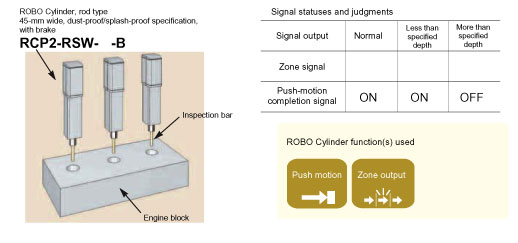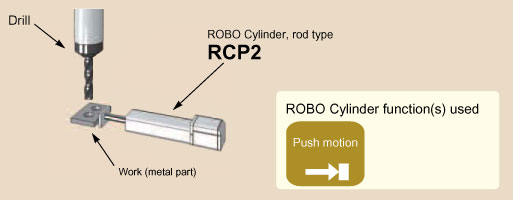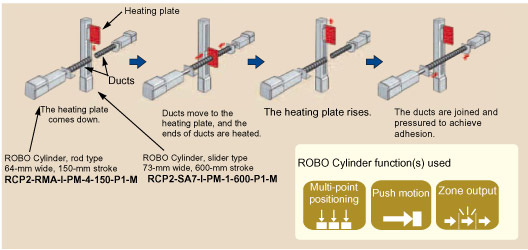Examples of Cost Savings with
ROBO Cylinder Electric Actuator Applications


![]()

Reduction of Initial Cost From $51,753.20 to $41,893.44*
Application - System inserts an inspection bar into a machined hole in an engine block to determine acceptability of machining.
The inspection bar is inserted into a machined hole using a ROBO Cylinder's electric actuator push-motion operation. This operation is combined with a zone signal to determine "normal," "less than specified depth" or "more than specified depth" at the position where a push-motion completion signal is output.

|
Air Cylinder
|
ROBO Cylinder
|
|---|---|
|
Air cylinder price: $802.15 (with length measuring function) (Inclusive of costs of brake, valve and other accessories)*
Required quantity - 9 air cylinders per system Number of systems - 7 sets throughout the factory Total cost of air cylinder system $802.15 x 9 units x 7 systems = $50,535.45* |
ROBO Cylinder price: $663.88 (includes the costs of brake, controller and cables)*
Required quantity - 9 air cylinders per system Number of systems - 7 sets throughout the factory Total cost of air cylinder system $663.88 x 9 units x 7 systems = $41,824.44 * |
* At the exchange rate of 109.74 JPY (Nov. 2007)
Explanation - The initial cost of the ROBO Cylinder electric actuator system is $41,824.44 compared to $50,535.45 required by the air cylinder system.
This resulted in cost savings of $8711.01.
The ROBO Cylinder electric actuator system also provides the following benefits:
Water-proofing - The air cylinder with length measuring function is not water-proof, but the ROBO Cylinder electric actuator series has a splash-proof type.
Improved Accuracy - While the encoder resolution is roughly the same between the air cylinder and ROBO Cylinder, the ROBO Cylinder electric actuator allows for finer position adjustment.
This improved the overall accuracy of the system.
(Note) The ROBO Cylinder electric actuator achieves a positioning accuracy of ±0.02mm with respect to the target position.
Improved Quality - With the ROBO Cylinder electric actuator, the thrust with which to push the inspection bar can be adjusted easily. As a result, work damage was eliminated.


Reduction of Initial Cost From $1,588.43 to $578.54*
Application - System press-fits a knob onto a shaft in an AT shift knob assembly process. The rod comes down quickly and then slowly pushes the knob onto the shaft. Once the knob is press-fit, the rod rises quickly. The press-fit condition is checked using a zone output signal.
|
Air Cylinder
|
ROBO Cylinder
|
|---|---|
|
Initial Cost
Cylinder (Ø50, 150-mm stroke, with auto switch; custom specification) $191.96* Distance Measuring Sensor Counter - $500.38* Valve, Etc. - $45.49* Other - $454.84* Sensor installation jig, counter installation box, wiring man-hours. Total $1588.43 |
Initial Cost
RCP2-RMA-I-PM-4-150-P1-M-FL - $353.84* Cables - $72.78* Total $578.54 |
* At the exchange rate of 109.74 JPY (Nov. 2007)
Explanation - The initial cost of the ROBO Cylinder electric actuator system is $578.54 *compared to $1588.43* required by the air cylinder system.
This resulted in cost savings of $1009.89*.
The ROBO Cylinder system also provides the following benefits:
Shorter Tact Time - The ROBO Cylinder can be moved slowly when press-fitting and quickly during approach and retreat. This resulted in a shorter tact time.
Improved Accuracy - With the ROBO Cylinder, the press-fit stroke can be set directly. This improved the accuracy of insertion depth.
Easy Changeover of Setup - Changing over to the ROBO Cylinder electric actuator set up is easier than ever.


43% Increase in Production Efficiency
Application - Clamping machine is used for machining metal automotive parts.
The work is clamped at 30N in the intitial rough-shaving stage where the work must be held securely. In the fine-machining stage after rough shaving, the push force is reduced to prevent the work from deforming.

|
Air Cylinder
|
ROBO Cylinder
|
|---|---|
|
With the air cylinder system, it takes 15 seconds to change the push force from 30N to 10N due to residual pressure. The work cannont be machined during this period.
Machining Time (Rough shaving: 13 seconds) + (Pressure change: 15 seconds) + (Fine machining: 13 seconds) + (Installation/removal: 8 seconds) = 49 seconds Production Volume Tact time (49 seconds) = 73 pieces/hour (3,600 seconds) = 1,763 pieces/day (24 hours) = 52,890 pieces/month (30 days) |
With the ROBO Cylinder system, the push force can be changed instantly by changing the position number.
Machining Time (Rough shaving: 13 seconds) + (Fine machining: 13 seconds) + (Installation/Removal: 8 seconds) = 34 seconds Production Volume Tact time (34 seconds) = 105 pieces/hour (3,600 seconds) = 2,520 pieces/day (24 hours) = 75,600 pieces/month (30 days) |
Explanation - (75,600 pieces - 52,890 pieces) / 52,890 pieces = 0.429 Approximately 43% increase in production
(Note) How to change ROBO Cylinder push force
The push force can be changed even during push-motion operation by simply changing the position number to one corresponding to a desired push force, as shown in the table to the right.
|
Position (#)
|
Position (mm)
|
Speed (mm/s)
|
Acceleration (G)
|
Push Force (%)
|
Push Band (mm)
|
|---|---|---|---|---|---|
|
1
|
100
|
200
|
0.3
|
30
|
10
|
|
2
|
100
|
200
|
0.3
|
70
|
10
|


Cost Reduction of $30,912*
Application - System heats and then adheres automotive ducts (resin pipes). ROBO Cylinders are used for moving the heating plate and ducts.
The heating position, joining position and other settings must be finely adjusted to achieve proper connection.

|
Air Cylinder
|
ROBO Cylinder
|
|---|---|
|
With the air cylinder system, adjusting the speed and push force at the time of joining ducts is difficult.
This caused adhesion problems, and the defect rate was approximately 10%.
Defect Rate - 10% Production Volume - 1,000 pieces/day = 20,000 pieces/month (20 days) = 240,000 pieces/year Unit price of part - $1.84 Annual loss of air cylinder system due to joining problems $1.84 x 240,000 pieces/year x 10% = $44,160 |
With the ROBO Cylinder system, the speed and push force can be adjusted easily.
As a result, the defect rate dropped to 3%.
Defect Rate - 3% Production Volume - 1,000 pieces/day = 20,000 pieces/month (20 days) = 240,000 pieces/year Unit price of part - $1.84 Annual loss of air cylinder system due to joining problems $1.84 x 240,000 pieces/year x 3% = $13,248 |
* At the exchange rate of 108.74 JPY (Nov. 2007)
Explanation - While the air cylinder system generated an annual loss of $44,160* it is $30,912* with the ROBO Cylinder System.
The effective savings are $13,248*.
The initial cost is $2763.96 for both the air cylinder system and ROBO Cylinder system.
According to the manufacturer, it would have cost the manufacturer $9,220.22 to produce a servo motor system in-house.


Ensuring Operator Safety
Application - Production line positioning automotive parts (horizontal transfer).
Safety is critical because the operator's hand could easily get caught.

|
Air Cylinder
|
ROBO Cylinder
|
|---|---|
|
Since actuating an emergency stop is difficult, the system will not stop even when the operator's hand gets caught.
This presented risk of injury. |
The push force can be reduced by lowering the moving torque.
If the operator's hand gets caught in this condition, no injury will result because the push force is small. In the meantime, an error will generate and the system will stop. |
(Note) The ROBO Cylinder can no longer guarantee the loading capacity, speed and other specifications listed in the catalog if the moving torque is lowered.
Therefore, the above function is disabled in normal conditions of use.
Please contact IAI if your system is subject to a special circumstance and this function must be enabled.




